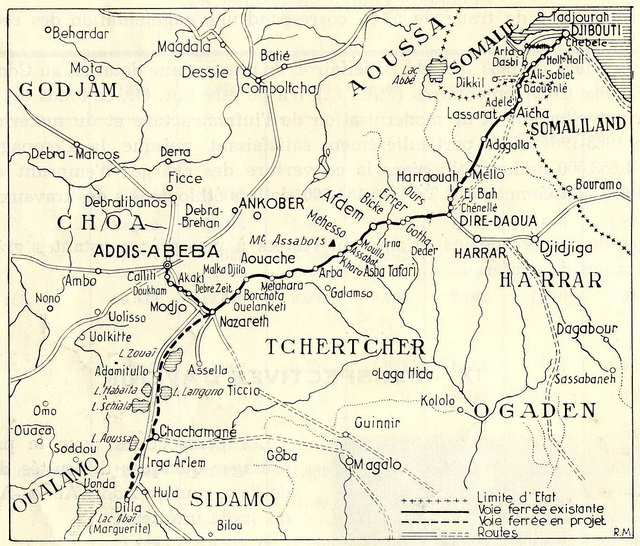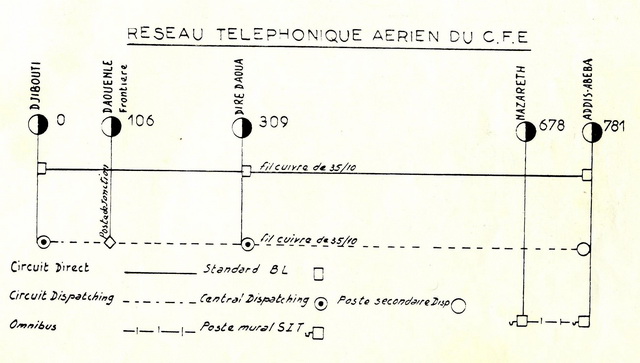THE RAILWAY LINE - THE FRANCO ETHIOPIAN RAILWAY FROM 1900 TO 1980.
Gallery N°3 : The railway line (C.F.E. period)
The laying of rails of 20 and 25 Kg/m took place between 1898 and 1914. These were manufactured at the "Mossbay Steel" factories and the "Homécourt et Joeuf" steelworks in France.
In 1947 the renovation and reinforcement of the line, and its structures, increased the permitted loading to 9.5 T per axle. Part of the track renovation was completed with rails of 30 Kg/m, manufactured by the "Wendel" factories in France. This renovation continued until 1975.
The rails, all of the "patin" flat bottomed base type, called "Vignoles", were fixed to metal sleepers of the "Menelik" type made in the "Virloy" and "Micheville" factories in France. The rails were secured by steel crapauds sleeper clips, nuts and bolts. They were laid on a ballast bed, usually 4 metres wide, made of crushed stones of chalky or volcanic origin.
There were also 75 kilometres of station tracks and specific branch lines.
LINE A : FROM DJIBOUTI TO DIRE-DAWA (310 kms)
Upon leaving Djibouti the line crosses mountainous foothills through a sandy and stony desert environment where only thorny plants manage to survive. It is a region of mirages where heaps of stones appear like lakes surrounded by trees. The area is sometimes whipped by winds that create high columns of sand. Once past the Harewa Bridge, the vegetation changes to bushy savannah and dense meadows near dried water beds (oueds). Primitive rock formations mark the Abyssian plateau with some scattered vegetation. After a long, steep incline which the trains cross using double traction, the line enters Dire-Dawa, a commercial and administrative centre, and the central meeting point of all the local products of the regions of Harrar and Tchercher. It is situated at an altitude of 1200 meters and was originally known as Addis Harrar.Djibouti to Ali Sabieh PK 89
- Ramp of 27 /1000
- Bend of R. 150m (one bend of R. 100m)
- Rails of 12m at 30 kg/m 1250/1500 sleepers per kilometre.
Ali Sabieh to Ayesha PK 145
- Ramp of 16/1000
- Bend of R. 300m
- Soldered rails of 108 m at 30 kg/m 1250/1500 sleepers per kilometre.
Ayesha to Shinile PK 297
- Ramps of 13,5 / 1000.
- Bends of R. 200m (one bend of R.160 and one of R.140 at the Harr Pass)
- Rails of 10m at 20kg/m 1600 sleepers per kilometre.
Shinile to Dire Dawa PK 310
- Ramps of 25/1000.
- Bends of R. 200m.
- Rails of 10m at 20kg/m 1600 sleepers per kilometre.
As an experiment, rails of 1507 m were welded together.
LINE B : FROM DIRE DAWA TO AWASH(230 kms)(1st part)
After leaving the station of Dire-Dawa, the Railway Line follows a path at the base of the Tchercher Mountains, gradually rising through a desert, sometimes sandy, sometimes rocky. It crosses the Assabots Pass at an altitude of 1480 metres, follows the base of the fertile northern slopes of the Tchercher at the edge of the Dankali desert. The line then runs down towards the Awash and crosses a big forest of Candelabra cactus trees (Euphorbia Candelabrum) and mimosa parasol trees on uneven terrain. It crosses the Awash River at an altitude of 846 metres over a 151 metre long by 60 metre high metal bridge. The small village of Awash has become a major tourist centre. The restaurant located next to the station has become a meeting point for all the travellers who wish to visit the High Plateaus of Arsis, Wollo and Aoussa.LINE B : FROM AWASH TO ADDIS ABEBA (244 kms)(2nd part)
On leaving the station at Awash the line crosses a grassy plateau, bordered to the south by the river, and descends through the vast Methara plain whose name derives from the neighbouring salt water lake; the line then climbs along the flanks of a volcanic massif, the "Fantale", and crosses enormous lava flows. From Borchotta onwards there are arable lands and dwellings occupied by sedentary tribes. Soon after Adama (Nazret), the line rises rapidly up to the Shoa plateau and snakes along a rich and populated area having a variety of cultures. Its main towns are Mojo, Debrezeit and Akaki. The line then arrives at Addis Ababa, at an altitude of 2400 meters.Reinforcement of the line and structures allow for a load per axle of 12 T:
- Ramp of 25/1000.
- Bend of R. 150m
- Rails of 12 m at 25 kg/m with 1250 to 1500 sleepers per kilometre.
- Rails of 15 m at 30 kg/m with 1466 sleepers per kilometre.
- Ballast of 500 litres per metre.
- 177 kilometres of welded tracks.
As an experiment, rails of 3455m were welded together.
It is expected that, upon completion, the replacement of all rails of 20 and 25 kilos by rails of 30 kilos throughout the line should allow for a 16 T load per axle. Replacement took place of the 11 metallic structures, of 4 and 6 metres, by tubes of type ARMCO.
LINE C : FROM ADAMA (NAZRET) TO DILLA (300kms)(PLANNED)
Between 1960 and 1965 a study was undertaken to consider the introduction of a Railway service to the southern part of Ethiopia.It was to originate at Adama (Nazret) and then cross the rich province of Sidamo, and provide a Railway service to the regions of the Arsis, Bale, Kaffa and Gommo-Goffa Gamu-Gofa.
It would cover some 300 kilometres and terminate at Dilla. The project was expected to take 4 years. All the studies demonstrated the rentability of this line. At that time the traffic was estimated at 24 million Kilometric Tons (TK). It would go up to 60 million TK within 5 years of the completion of the project and up to 99 million TK ten years later.
This line would be owned entirely by the Ethiopian Government and would assist in the development of the affected areas, which are heavily populated, rich in the production of coffee, dry vegetables, oleaginous plants and wood.
This study remained at the project stage.

click on the map
TELECOMMUNICATION AND THE C.F.E.
Telephone communication operates as depicted in the diagram below :Three centres are linked via a direct circuit by an auto switching commutation device. A dispatch circuit links each station to its respective central post. Moreover, a "point to point" teleprinter circuit assures telegraphic contact between the three centres.

The telephone line follows the track. The copper wire used occasionally causes"some envy" and is prone to pilfering. Each train guard is equipped with a pole and a field telephone in order to connect to the network in case of accident or stoppage on the line. He also carries all the necessary equipment to replace and/or repair any missing components.
THE RAILWAY LINE - THE DJIBOUTI-ETHIOPIAN RAILWAY AFTER 1980.
Gallery N°4 : The railway line (C.D.E. period)
This Railway covers 784 kilometres from an altitude of 0m at Djibouti to 2400m at Addis Ababa. It has a gauge of 1000 mm.
During the period from 1947 to 1975, a reinforced track with rails of 30 kg/m manufactured by the "Wendel" factories was installed in certain sections. These rails, all of the "patin" flat bottomed base type, called "Vignoles", were fixed to the metal sleepers, of the "Menelik" type and made in the "Virloy" and "Micheville" factories in Lyon, by steel crapauds sleeper clips, nuts and bolts. They were laid on a ballast bed of crushed stones of chalky or volcanic origin, depending on the region being crossed. The track bed was usually 4 metres wide.
A few of the original sleepers laid at the beginning of construction of the line are still in place. It is still possible today to catch a glimpse of some of them, dating from 1913, at the Awash Station.
In the years after 1974, at the end of the reign of the Negus, the Emperor of Ethiopia, the ideology of the then political regime resulted in a deterioration of the Railway and its installations due to lack of maintenance and lack of interest in business. During this period, the Ethiopian authorities favoured road transport and the passage of merchandise through the port of Assab in Erythrea, then a full province of the country. Since the war of independence of Erythrea, Ethiopia has relied solely on Djibouti as its access to the sea, with a deficient Railway corridor and a badly kept road. This was detrimental to the economic development of a country in full expansion.
In order for both heavier and more numerous convoys to use the line, a study was undertaken: to improve the route and increase the speed of travel; rectifying bends and replacing portions of the track which dated back to the earliest construction of the line; replacing rails of 20 and 25 kg/m, that had been manufactured by the "Mossbay Steel" Factory, by reinforced rails of 36 and 40 kg/m designed to carry a load of 17 tons per axle.
LINE A : FROM DJIBOUTI TO DIRE-DAWA (310km)
Djibouti to Ali-Sabieh PK 89- Ramp of a maximum 27 / 1000
- Bends with a minimum radius of 150m (one bend of R. 100m)
- Rails of 30 kg/m placed on metal sleepers of the "Menelik" type
Ali Sabieh to Didille PK 175 - Ramps of a maximum of 16 / 1000
- Bends with a minimum radius of 300m
- Rails of 30 kg/m placed on metal sleepers of the "Menellik" type
Didille to Adigale PK 202
- Ramps with a maximum of 13.5/1000. Passage of the Haar pass and tunnel.
- Bends with a minimum radius of 200m.
- Rails of 36 kg/m placed on metal sleepers of the "Menelik" type.
Adigale to Shinile PK300
- Ramp with a maximum of 13.5 / 1000.
- Bends with a minimum radius of 200m.
- Rails of 40 kg on monoblock concrete sleepers, with Pandrol fastclip® fixings.
Shinile to Dire Dawa PK 310
- Ramps with a maximum of 25 / 1000
- Bends with a minimum radius of 200m
- Rails of 40 kg/m on monoblock concrete sleepers, with Pandrol Fastclip® fixings.
LINE B : FROM DIRE DIRE DAWA TO ADDIS ABEBA (472 Kms)
Maximum ramp of 25 / 1000.- Bends with a minimum radius of 150 m.
- 46 kms with rails of 30 kg/m on metal sleepers of the "Menelik" type.
- 25 kms with rails of 36 kg/m on metal sleepers of the "menelik" type.
- 11 kms on rails of 40 kg/m on monoblock concrete sleepers, with Pandrol Fastclip® fixings.
- 390 kms with rails of 25 kg/m on metal sleepers of the "Menelik" type.
Funds from the European Union bore the cost of renovation of part of the line. The works should have been completed during 2009.
Two companies were commissioned to undertake the works: an Italian company, CONSTA MATTIOLI, and a Spanish Company, INECO TIFSA, the latter being responsible for :
- A new platform to cross the Besaka Lake, able to carry a track with rails of 40 kg/m
- The construction in Dire-Dawa of a factory able to manufacture 15000 concrete monoblock sleepers per month.
- The construction in Doukham, in the suburbs of Addis-Ababa, of a workshop responsible for the construction and assembly of metal components for bridges.
The new track is made up of rails of 40 kg/m lying on monoblock concrete sleepers and attached with Pandrol Fastclips®.
In the future, Ethiopia is planning a Railway of 5000 km linking Sudan with Kenya, and passing through Nazreth: a decision still has to be made about the gauge…
